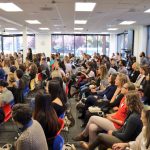The annual flagship event of Women in Cleantech & Sustainability is always informative, enlightening — and fun. The 300 women and men who attended this year were energized from the moment moderator and WCS Founder Lisa Ann Pinkerton opened the event till the last networker left the post-talks happy hour. The word on everyone’s lips: “inspiring.”
Women also tend to make connections and see things in a holistic way. Many of the speakers talked about the importance of systems in advancing sustainability efforts.
It was a day full of hope. “All of us sharing ideas is how we’re going to make progress,” noted Beth Sturgeon, Team Analyst and Operations Manager at Google, which generously hosted WCS Talks for the second year in a row.
How business can lead the way
Kate Brandt, Google’s Lead for Sustainability, emphasized how businesses can lead the way in promoting a “circular economy” that’s more than just a buzzword. She was one of several speakers who pointed to the need to look beyond the details to the systems we’re part of. We need to fully reexamine the economic model that’s led us to consume 1.5 times what the earth can provide, she said. That’s where the circular economy comes in, with its recognition that we need a different model for prosperity, and its potential to unlock new value from waste streams. Google, the largest corporate non-utility buyer of renewable energy in the world, is well positioned to lead the way. Their list of sustainable actions is long, but Brandt said Google has really just begun. The company’s vision? To become the global reference point for the circular economy.
If this wasn’t enough to get you inspired, Susan Mac Cormac, Partner at Morrison & Foerster, was sure to do the trick. Words on a page can’t capture the energy and charisma she emanated. She got our attention with the statement, “Sustainability is like the red pill.” This is a woman who’s up for facing reality, and she encouraged us all to do the same. That means, Mac Cormac asserted, no less than changing the structural systems of our world. We’re headed for a cliff, and all our economic models are flawed, based as they are on the premise that we can gradually apply the brakes before getting to the cliff. So, what do we do? Invest trillions of dollars in solutions. The good news? We’re seeing a growing investment in sustainable businesses and new corporate forms being used for impact. Who would have thought corporate form could be as interesting as she made it?
You might say the same for open standards. But Rachel Moses, Director of Infrastructure Solutions at Greenlots, highlighted how crucial open standards are for accelerating electrification around the world. Without open standards, she’s installed charging structures that were later ripped out. With cars soon hitting road our roads that will have a 250-mile range and a reasonable price, we need systems that can work together to accommodate them. Open standards, said Moses, are the only way we can make this scale.
Business opportunities
One cool one is Tumml, which has so far supported 38 urban innovation startups. Tumml Founder and President Julie Lein, while showing appreciation for the dating and photo sharing apps everyone else seemed to be working on, wanted to help address urbanization challenges. So she and her co-founder launched an accelerator program. A few of their success stories convey some important startup lessons:
- Chariot, a crowdsourced commuter van shuttle, showed that execution trumps all.
- SkyCool Systems, a panel that harnesses cooling on the roof, showed that you must be scrappy when raising early-stage funding.
- Valor Water Analytics showed that it’s all about your team, which will make or break your startup.
- Hive Lighting, maker of ultra-efficient lighting, showed that more money = more impact.
Moving clean energy and efficiency forward
But most consumers aren’t aware of this, just as they don’t think much about energy efficiency. Karen Zelmar, Director of Energy Efficiency Programs at PG&E, reminded us of how uncool energy efficiency is, although it’s considered “the first fuel.” PG&E has an ambitious goal this year to reduce power usage in northern California by 650 GW, or one power plant’s worth. That’s in a state that’s already flattened its energy use per capita since 1970, at a time when energy used doubled in the rest of the country. Already, about 50 power plants have not been built in California because of energy efficiency. Now, California has a mandate to increase efficiency by 50%. That means we need to nudge people to change their behaviors — never an easy undertaking.
If it can be done anywhere, it can be done in California, which Jayant Kairam, director of California Clean Energy at the Environmental Defense Fund, called “ground zero for climate reform” and a “too big to fail situation.” That, plus the state’s bold energy policy foundation, $3 billion in clean energy investments and 500,000 clean energy jobs, make California a great place to work on electricity sector reform. By 2030, Kairam expects to see a regional energy market, which he hopes will be aided by well-designed time-of-use rates. Kairam, one of our two “token males” at WCS Talks, ended with this nice slide:
What’s happening around the world
One example is Gemma Bulos, Co-Founder of the Global Women’s Water Initiative. At a UN water conference, she learned that 1.2 billion people didn’t have access to water, many are dying from water-related diseases, and this disproportionately affects women and girls. Bulos told inspiring stories of the Women’s Water Leadership Academy, which trains women in sub-Saharan Africa in water access, quality, sanitation, and hygiene. Why women? Bulos quoted an African saying: “You train a man, you train an individual: you train a woman, you train a nation.” What better illustration of this than the fact that over 44,000 people have been impacted by 10 teams of women? The women trained — some of whom had just an 8th grade education and had been sex workers — also gained confidence and influenced policy. These women, she said are challenging the status quo. “Be that drip of water that will start that wave,” she challenged us, “that will change the world.”
Another major issue in sub-Saharan Africa is that 1 in 38 women there have a chance of dying from preventable childbirth complications. Dr. Laura Stachel, Founder of WeCare Solar, has helped to lower that risk with a simple solution: light. She learned that many hospitals in the area don’t have electricity for 12 hours a day. That means no lighting and no refrigerators for blood and medications. Statchel and her husband designed a small solar system that’s easy to maintain, and over the next year, the number of deaths in a hospital for women went down by 70%. Now, hundreds of health facilities in Africa and other parts of the world use their “solar suitcase” with batteries, efficient lights, and headlamps.
While different parts of the world have their specific needs, there are some global trends when it comes to energy use. Julia Murphy, Managing Director of Ultra Capital, noted that the world is moving to more distributed energy — it’s no longer a question of if, but when, she said. Meanwhile, resource limitations in water use, agriculture, and energy are spurring innovations in these areas. What’s the opportunity? Huge! High impact, said Murphy, equals high returns. We have an opportunity that will reframe the world’s economy and create opportunities for trillions of dollars in impactful investment.
The progress of women
Emily Leung, Senior Sales Manager at NEXTracker, said that as her company — the fastest-growing solar company ever — has grown from 30 to 300 employees, 30% of those are now women. Their CEO has been supportive, and sponsored 15 women to attend this year’s WCS Talks. Groups like this one where we can come together and highlight issues, said Leung, are important in creating opportunities for women. “We’re progressing,” she said, “and collectively, we will continue to progress.”
That doesn’t mean there isn’t a lot more progress to be made. Dr. Maslina Tasrin Othman, on the R&D technical team at Tetrasun-First Solar, spoke about challenges she’s faced working in R&D. In the high-tech workforce, she said, some are still using old templates. She came across an offering of a Bible and condom while working abroad, and in another case was served dinner only after the men ate. Some of her women counterparts even quit because of this work environment. But everyone, she said, is responsible for changing the old template to create an environment conducive to women professionals.
Most careers don’t follow a straight path, a sentiment echoed by Adrienne Pierce, Head of Business Development at The CSR Group. The key to following the path, even if it’s winding? Examine your gut. Talk to people, she recommended, go to events, take classes, volunteer. “Where you like to spend your time,” she said, “is what feeds your soul.” She cautioned that this doesn’t happen overnight — her own process began over three years ago. And it might not always be comfortable. But when you get nervous, Pierce said, that’s a really good indication of how important it is to you. She challenged us: “If you don’t write your story, it will be written for you.”
A paradigm shift
One way we can think about the future is by envisioning a paradigm shift. Chris DeVolder, Vice President at HOK and our second token male, asked us to keep sight of our intention, and of the language we use. Instead of the language of scarcity — minimize, reduce, efficient, streamline – we can use the language of abundance: enhance, generate, create, harvest, add. In the language of abundance, the sum of the parts is greater than the whole. His call to action: Think about how your intention and abundance can overlap with other folks. “How can you connect the dots?” he asked. “We all live a life of occasion — let’s rise to it.”
Someone who is clearly rising to the occasion is Elizabeth Bagley, Manager at the California Academy of Sciences. Her work at the museum has a lot to do with making connections and looking at the details as parts of a much bigger system. Museums are starting to talk about sustainability, as trusted messengers and ideal places to share sustainability stories. They can focus on the science behind the problems but also on the solutions, and get people to think about things like how much water they can save by eating just a bit differently. The museum, she said, is working to inspire their guests to think about cleantech and sustainability solutions. “Your work.” she added, “depends on us being effective storytellers.” And all our work depends on hope — and the understanding that we hold solutions to build a more sustainable world.
How are you planning to build a more sustainable world? If you have ideas, stories, or inspiration to share, be sure to apply to speak at next year’s WCS Talks!













